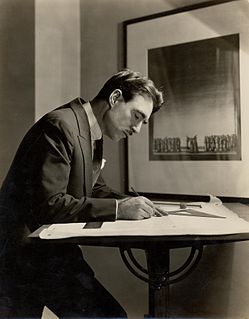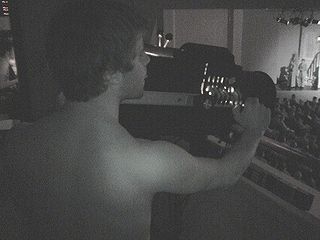During pre-production
The role of the lighting designer varies greatly within professional and amateur theater. For a Broadway show, a touring production and most regional and small productions the LD is usually an outside freelance specialist hired early in the production process. Smaller theater companies may have a resident lighting designer responsible for most of the company's productions or rely on a variety of freelance or even volunteer help to light their productions. At the off-Broadway or off-off-Broadway level, the LD will occasionally be responsible for much of the hands-on technical work (such as hanging instruments, programming the light board, etc.) that would be the work of the lighting crew in a larger theater.
The LD will read the script carefully and make notes on changes in place and time between scene—and will have meetings (called design or production meetings) with the director, designers, stage manager, and production manager to discuss ideas for the show and establish budget and scheduling details. The LD will also attend several later rehearsals to observe the way the actors are being directed to use the stage area ('blocking') during different scenes and will receive updates from the stage manager on any changes that occur. The LD will also make sure that they have an accurate plan of the theatre's lighting positions and a list of their equipment, as well as an accurate copy of the set design, especially the ground plan and section. The LD must take into account the show's mood and the director's vision in creating a lighting design. [1]
To help the LD communicate artistic vision, they may employ renderings, storyboards, photographs, reproductions of artwork, or mockups of effects to help communicate how the lighting should look. Various forms of paperwork are essential for the LD to successfully communicate their design to various members of the production team. Examples of typical paperwork include cue sheets, light plots, instrument schedules, shop orders, and focus charts. Cue sheets communicate the placement of cues that the LD has created for the show, using artistic terminology rather than technical language, and information on exactly when each cue is called so that the stage manager and the assistants know when and where to call the cue. Cue sheets are of the most value to stage management.
The light plot is a scale drawing that communicates the location of lighting fixtures and lighting positions so a team of electricians can independently install the lighting system. Next to each instrument on the plan will be information for any color gel, gobo, or other accessories that need to go with it, and its channel number. Often, paperwork listing all of this information is also generated by using a program such as Lightwright. The lighting designer uses this paperwork to aid in the visualization of not only ideas but also simple lists to assist the master electrician during load-in, focus, and technical rehearsals. Professional LDs generally use special computer-aided design packages to create accurate and easily readable drafted plots that can be swiftly updated as necessary. The LD will discuss the plot with the show's production manager and the theatre's master electrician or technical director to make sure there are no unforeseen problems during load-in.
The lighting designer is responsible, in conjunction with the production's independently hired production electrician, who will interface with the theater's master electrician, for directing the theater's electrics crew in the realization of their designs during the technical rehearsals. After the Electricians have hung, circuited, and patched the lighting units, the LD will direct the focusing (pointing, shaping and sizing of the light beams) and gelling (coloring) of each unit.
After focus has occurred the LD usually sits at a temporary desk (tech table) in the theater (typically on the center line in the middle of the house) where they have a good view of the stage and work with the light board operator, who will either be seated alongside them at a portable control console or talk via headset to the control room. At the tech table, the LD will generally use a Magic Sheet, which is a pictorial layout of how the lights relate to the stage, so they can have quick access to channel numbers that control particular lighting instruments. The LD may also have a copy of the light plot and channel hookup, a remote lighting console, a computer monitor connected to the light board (so they can see what the board op is doing), and a headset, though in smaller theatres this is less common. There may be a period of time allowed for pre-lighting or "pre-cueing", a practice that is often done with people known as Light Walkers who stand in for performers so the LD can see what the light looks like on bodies. At an arranged time, the performers arrive and the production is worked through in chronological order, with occasional stops to correct sound, lighting, entrances, etc.; known as a "cue-to-cue" or tech rehearsal. The lighting designer will work constantly with the board operator to refine the lighting states as the technical rehearsal continues, but because the focus of a "tech" rehearsal is the production's technical aspects, the LD may require the performers to pause ("hold") frequently. Nevertheless, any errors of focusing or changes to the lighting plan are corrected only when the performers are not onstage. These changes take place during 'work' or 'note' calls. The LD only attends these notes calls if units are hung or rehung and require additional focusing. The LD or Assistant Lighting Director (also known as the ALD, see below for description) will be in charge if in attendance. If the only work to be done is maintenance (i.e. changing a lamp or burnt out gel) then the Production or Master Electrician will be in charge and will direct the electrics crew.
After the tech process, the performance may (or may not, depending on time constraints) go into dress rehearsal without a ticketed audience or previews with a ticketed audience. During this time, if the cueing is finished, the LD will sit in the audience and take notes on what works and what needs changing. At this point, the stage manager will begin to take over the work of calling cues for the light board op to follow. Generally, the LD will stay on the headset, and may still have a monitor connected to the light board in case of problems, or will be in the control booth with the board operator when a monitor is not available. Often, changes will take place during notes call, but if serious problems occur the performance may be halted and the issue will be resolved then.
Once the show is open to the public, the lighting designer will often stay and watch several performances of the show, making notes each night and making desired changes the next day during notes call. If the show is still in previews, then the LD will make changes, but once the production officially opens, normally, the lighting designer will not make further changes.
Changes should not be made after the lighting design is finished, and never without the LD's approval. There may be times when changes are necessary after the production has officially opened. Reasons for changes after opening night include: casting changes; significant changes in blocking; addition, deletion or rearrangement of scenes; or the tech and/or preview period (if there was a preview period) was too short to accommodate as thorough a cueing as was needed (this is particularly common in dance productions). If significant changes need to be made, the LD will come in and make them, however, if only smaller changes are needed, the LD may opt to send the ALD. If a show runs for a particularly long time then the LD may come in periodically to check the focus of each lighting instrument and if they are retaining their color (some gel, especially saturated gel, loses its richness and can fade or 'burn out' over time). The LD may also sit in on a performance to make sure that the cues are still being called at the right place and time. The goal is often to finish by the opening of the show, but what is most important is that the LD and the directors believe that the design is finished to each's satisfaction. If that happens to be by opening night, then after opening no changes are normally made to that particular production run at that venue. The general maintenance of the lighting rig then becomes the responsibility of the Master Electrician.











